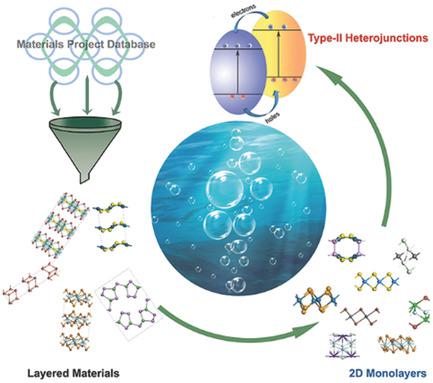当前位置:
X-MOL 学术
›
Small Methods
›
论文详情
Our official English website, www.x-mol.net, welcomes your
feedback! (Note: you will need to create a separate account there.)
Computational Screening of 2D Materials and Rational Design of Heterojunctions for Water Splitting Photocatalysts
Small Methods ( IF 10.7 ) Pub Date : 2018-04-10 , DOI: 10.1002/smtd.201700359 Xu Zhang 1 , Zihe Zhang 1 , Dihua Wu 1 , Xin Zhang 1 , Xudong Zhao 1 , Zhen Zhou 1
Small Methods ( IF 10.7 ) Pub Date : 2018-04-10 , DOI: 10.1002/smtd.201700359 Xu Zhang 1 , Zihe Zhang 1 , Dihua Wu 1 , Xin Zhang 1 , Xudong Zhao 1 , Zhen Zhou 1
Affiliation

|
As the energy crisis and environmental issues become increasingly serious, photocatalytic water splitting has received extensive attention as a promising method for the production of clean energy. However, available photocatalysts still have a long way to go. In light of the inherent advantages of 2D materials, reducing the thickness of nanosheets to monolayers is an effective strategy to achieve high photocatalytic activity. In this work, over 50 000 inorganic compounds from the Materials Project Database are screened, and 205 layered materials are obtained as candidates for water splitting photocatalysts. By exfoliating those layered materials and further examination, 36 kinds of 2D monolayers with validated stability and appropriate band edge position are achieved. To further enhance the photocatalytic activity, type‐II van der Waals heterostructures are fabricated according to structure and band edge position, and show ideal band edge positions with effective spatial separation of electrons and holes. From layered materials to 2D monolayers and then to type‐II heterojunctions, a high‐throughput computational materials design framework is proposed to gradually enhance the quantum efficiency and performance for photocatalytic water splitting. This screening algorithm exhibits excellent credibility and feasibility, and meanwhile provides substantial candidate catalysts for consequent experimental investigations on photocatalytic water splitting.
中文翻译:

二维材料的计算筛选和水分解光催化剂异质结的合理设计
随着能源危机和环境问题变得越来越严重,光催化水分解作为生产清洁能源的一种有前途的方法已受到广泛关注。但是,可用的光催化剂还有很长的路要走。鉴于2D材料的固有优势,将纳米片的厚度减小为单层是实现高光催化活性的有效策略。在这项工作中,从“材料项目数据库”中筛选了5万多种无机化合物,并获得205种层状材料作为水分解光催化剂的候选材料。通过剥落这些分层材料并进行进一步检查,可以实现36种2D单层,具有经过验证的稳定性和适当的带边缘位置。为了进一步增强光催化活性,II型范德华异质结构是根据结构和能带边缘位置制造的,并显示出理想的能带边缘位置,并有效地分离了电子和空穴。从分层材料到2D单层,再到II型异质结,提出了一种高通量计算材料设计框架,以逐步提高光催化水分解的量子效率和性能。该筛选算法具有极好的可信度和可行性,同时为后续的光催化水分解实验研究提供了重要的候选催化剂。从分层材料到2D单层,再到II型异质结,提出了一种高通量计算材料设计框架,以逐步提高光催化水分解的量子效率和性能。该筛选算法具有极好的可信度和可行性,同时为后续的光催化水分解实验研究提供了重要的候选催化剂。从分层材料到2D单层,再到II型异质结,提出了一种高通量计算材料设计框架,以逐步提高光催化水分解的量子效率和性能。该筛选算法具有极好的可信度和可行性,同时为后续的光催化水分解实验研究提供了重要的候选催化剂。
更新日期:2018-04-10
中文翻译:

二维材料的计算筛选和水分解光催化剂异质结的合理设计
随着能源危机和环境问题变得越来越严重,光催化水分解作为生产清洁能源的一种有前途的方法已受到广泛关注。但是,可用的光催化剂还有很长的路要走。鉴于2D材料的固有优势,将纳米片的厚度减小为单层是实现高光催化活性的有效策略。在这项工作中,从“材料项目数据库”中筛选了5万多种无机化合物,并获得205种层状材料作为水分解光催化剂的候选材料。通过剥落这些分层材料并进行进一步检查,可以实现36种2D单层,具有经过验证的稳定性和适当的带边缘位置。为了进一步增强光催化活性,II型范德华异质结构是根据结构和能带边缘位置制造的,并显示出理想的能带边缘位置,并有效地分离了电子和空穴。从分层材料到2D单层,再到II型异质结,提出了一种高通量计算材料设计框架,以逐步提高光催化水分解的量子效率和性能。该筛选算法具有极好的可信度和可行性,同时为后续的光催化水分解实验研究提供了重要的候选催化剂。从分层材料到2D单层,再到II型异质结,提出了一种高通量计算材料设计框架,以逐步提高光催化水分解的量子效率和性能。该筛选算法具有极好的可信度和可行性,同时为后续的光催化水分解实验研究提供了重要的候选催化剂。从分层材料到2D单层,再到II型异质结,提出了一种高通量计算材料设计框架,以逐步提高光催化水分解的量子效率和性能。该筛选算法具有极好的可信度和可行性,同时为后续的光催化水分解实验研究提供了重要的候选催化剂。











































 京公网安备 11010802027423号
京公网安备 11010802027423号